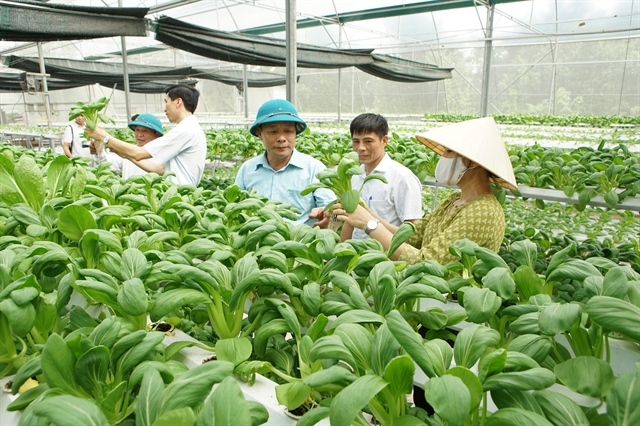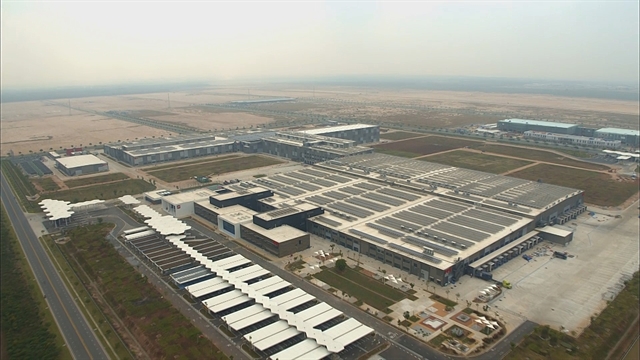 Environment
Environment


|
| Growing hydroponic vegetables without using pesticides in Phú Cường Commune, Sóc Sơn District. — Photo courtesy of the city’s Department of Agriculture and Rural Development. |
HÀ NỘI — Hà Nội’s farmers have applied advanced science and technology and switched their crops towards organic production with an aim to supplying safe food to domestic and international customers.
According to the city’s Department of Agriculture and Rural Development, green agriculture synchronises production processes, saves input materials, and uses technology and natural resources in a reasonable and effective way.
Nguyễn Thị Hải, a farmer in Đan Phượng District, catches crabs and loaches in rice fields as a way to increase her income.
Her family has experience applying modern rice cultivation methods combined with sparse planting, high quality seeds and proper water regulation.
After using a combine harvester to collect rice, farmers leave the straw in the fields as fertiliser for the next crop. This method helps reduce the amount of chemical fertiliser by up to 70 per cent and eliminate pesticide usage.
Hải said after more than 10 years of circular farming, her family and many other households in the district have created a sustainable ecosystem.
Rice by-products are turned into fertiliser for the next crop. Most shrimp, crabs, loaches and fish can reproduce naturally in rice fields, she said.
This method not only takes advantage of natural food sources in rice fields but also minimises environmental pollution and diseases on plants, she said.
In Đông Anh District, one of the most famous areas for growing clean vegetables in the capital city, farmers are now able to control the quality of safe vegetables in concentrated production areas.
This was achieved thanks to a vegetable production area covering 1,180 hectares, of which more than 500 hectares are set aside for concentrated, large-scale safe production.
To maintain safe agricultural production, the district has strengthened communication campaigns to raise public awareness on the harmful effects of using pesticides.
A survey by authorities showed farmers in the district have mostly switched to organic fertilisers, microorganisms and herbs in agricultural cultivation.
Vũ Thị Hương, director of the Hà Nội Agricultural Extension Centre under the city’s Department of Agriculture and Rural Development, said green agriculture has recently boomed with various models such as the garden - pond - barn farming system, intercropping and mixed cropping.
Waste from livestock is utilised for farming, and crop by-products are used as animal feed and aquaculture, she said.
Circular farming models such as rice - fish and rice – duck ensure nutrition and adapt to climate change. In the context of rising production costs, these multi-crop models are increasingly dominant, helping local people stay in farming, she said.
The city’s green agricultural models are booming in the districts of Sóc Sơn, Đông Anh, Phú Xuyên, Thạch Thất, Ứng Hòa and Đan Phượng.
Green agricultural products that ensure strict hygiene and safety requirements not only meet the demand of domestic consumers, but are also exported, bringing high economic value to farmers.
Hà Nội has created 164 high-tech agricultural production models. The value of high-tech agricultural products currently accounts for about 35 per cent of the city's total agricultural production value.
Smart technology and equipment have been applied in environmental management and control.
Hoàng Văn Thám, director of Chúc Sơn Clean Fruit and Vegetable Cooperative, said his cooperative is the first unit in Chương Mỹ District to coordinate with scientists to install the iMetos 3.3 A-G - a smart weather monitoring station system.
With a coverage radius of 15km, the monitoring station accurately forecasts temperature, wind speed and rainfall, serving as a basis for farmers to develop plans to care for and protect vegetables and fruits.
Chúc Sơn Clean Fruit and Vegetable Cooperative has supplied two to three tonnes of clean vegetables and fruits to supermarkets nationwide each day in recent years.
The vegetables and fruits are also purchased by Japanese companies and distributed to the Japanese community in Việt Nam.
Nguyễn Mạnh Phương, deputy director of the Hà Nội Department of Agriculture and Rural Development, said developing green agriculture is an inevitable trend of modern agriculture. Hà Nội has converted tens of thousands of hectares of low economic efficiency rice land to new agricultural production models.
These models not only create clean food sources but also provide 15 – 20 per cent higher economic efficiency than traditional agricultural production methods, while also curbing environmental pollution, he said.
Hà Nội has over 5,000 hectares of safe vegetables, more than 50 hectares of organic vegetables and many high-tech agricultural production models. In fact, local farmers are now more concerned about using biological pesticides and herbs, he said.
To expand green agricultural production areas, the city's agricultural sector has coordinated with localities to advise farmers not to use chemical pesticides and drugs not on the permitted list, he said.
Local authorities have also created favourable conditions to attract businesses to invest in green agriculture and build more high-tech agricultural models, he said.
Phương said in the long run, Hà Nội’s farmers need to change their perception, switch from habitual practices to methods recommended by experts, scientists and State management agencies.
To facilitate green, environmentally-friendly agriculture, Hà Nội needs to invest in infrastructure, product branding and codes for planting areas. By 2025, organic farming areas are set to make up 1.5 – 2 per cent of total farming land. The city has also set green production as a spearhead of the agricultural sector, Phương said. — VNS




